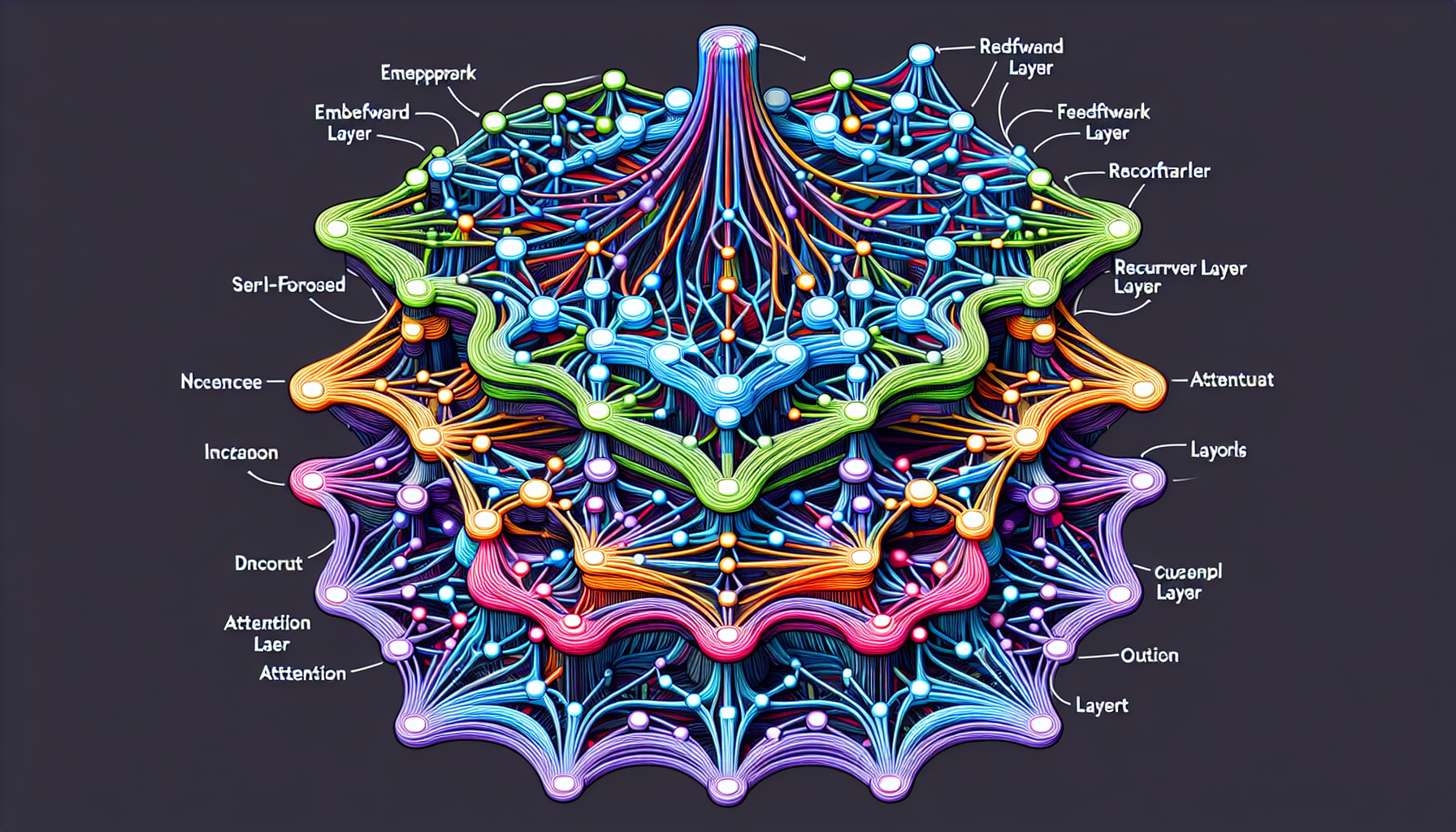How does large language model LLM work? By applying advanced machine learning to analyze and mimic the structure of human language, LLMs effectively predict and generate text. From chatbot responses to nuanced summaries, an LLM’s underlying functions hinge on pattern recognition within vast datasets—a process we’ll unravel in this exploration.
Key Takeaways
Large language models (LLMs) use deep learning algorithms and function primarily on the transformer model, leveraging extensive datasets to perform a wide array of language-related tasks, including natural language processing and text generation.
LLMs require extensive pre-training to understand grammar, syntax, and world knowledge, followed by fine-tuning on specific tasks to improve accuracy and adapt to domains, which can be enhanced by advanced techniques like reinforcement learning from human feedback (RLHF).
The practical applications for LLMs are vast and include code generation, enhancing search engines, sentiment analysis, and content creation, but their deployment faces challenges such as addressing bias, ensuring fairness, and mitigating security and misinformation risks.
The Core of Large Language Models

Large language models (LLMs) fundamentally use deep learning algorithms to process and comprehend voluminous text data. As autoregressive models built on transformer models, LLMs ingest text input and sequentially predict the following word or token, thus producing text that is coherent and contextually fitting. This is how large language models work. To maintain large language models, it is crucial to ensure their continuous learning and adaptation to new data.
Some key features of LLMs include:
They are built on transformer models
They use large datasets for training
They can recognize, translate, forecast, or generate text and other types of content
These features enable LLMs to generate high-quality text output and perform a wide range of language-related tasks.
Fine-tuning is an integral aspect of large language model performance. Pre-training concentrates on instructing the models to produce text, while fine-tuning customizes these models to respond aptly to particular inputs like questions or commands. This approach boosts the model’s performance and broadens its applicability across a diverse range of applications, including:
Conversational AI in chatbots
Sentence completion
Question answering
Text summarization
The Transformer Model: A Breakthrough in AI
Large language models, such as GPT-3 and GPT-4, rely on the transformer model, a breakthrough in artificial intelligence. These models utilize deep learning algorithms to acquire knowledge of the statistical connections among words, phrases, and sentences. Through extensive pre-training on substantial datasets and the utilization of neural networks, particularly transformers, these models can:
Produce coherent and contextually appropriate text
Generate creative and original content
Understand and respond to user prompts
Provide accurate information and answers
The transformer model has revolutionized natural language processing and has numerous applications in various fields, including chatbots, content generation, language translation, and more.
One of the key elements of the transformer model is the self-attention mechanism. This allows the model to:
Comprehend and identify the relationships and connections between words and concepts
Allocate significance to different parts of the input
Expedite the learning of patterns compared to traditional models.
Moreover, a transformer model handles data by tokenizing the input, then performing mathematical operations concurrently to uncover relationships between these tokens, thereby ensuring the process is efficient and effective.
From Raw Data to Understanding
Converting raw data into profound understanding is fundamental to how large language models operate. LLMs experience pre-training, during which they learn grammar, syntax, and world knowledge from sizable datasets. This process allows the models to represent and understand the statistical connections among words, phrases, and sentences.
Once pre-training is complete, the fine-tuning process ensues. In this stage, the models undergo training on a smaller, task-specific dataset, which helps them to adapt and specialize in a particular domain, resulting in increased precision and accuracy. For instance, if an LLM is fine-tuned on data involving frequent summary creation by individuals, it can generate accurate and relevant summaries when requested.
Fine-Tuning for Precision
Despite seeming like a minor adjustment process, fine-tuning is in fact a critical element in optimizing large language models.
Fine-tuning consists of:
Training the already pre-trained model on a smaller, task-specific dataset
Enabling the model to adapt and specialize in a specific domain
Leading to enhanced precision and accuracy.
Beyond traditional fine-tuning, advanced methods like reinforcement learning from human feedback (RLHF) and instruction tuning are also employed to boost the performance of LLMs. RLHF, for instance, aligns the model’s output with human values and preferences, refining the model’s responses. Meanwhile, instruction tuning involves training the model using only high-quality instruction and response pairs, thereby enhancing the model’s performance and usefulness.
Inside the Neural Network: The Building Blocks of LLMs

Similar to how a building is constructed with bricks, large language models are constructed using numerous building blocks referred to as neural network layers. These layers, which include:
Recurrent layers
Feedforward layers
Embedding layers
Attention layers
Work together to process and understand input text in human language.
The different layers in the model include:
Recurrent layer: Deciphers the words in the input sequence and captures the relationship between words within a sentence.
Feedforward layer: Alters the input embeddings, enabling the model to draw out higher-level abstractions, which assists in understanding the user’s intent.
Embedding layer: Changes the input into embeddings that embody the semantic and syntactic meaning.
Attention mechanism: Allows the model to concentrate on specific portions of the input relevant to the current task.
These layers work together to enhance the foundation models’ understanding and performance.
Layers Upon Layers: How Deep Learning Works
Deep learning, a branch of machine learning, forms the core of large language models. Through the use of neural networks comprising three or more layers, deep learning enables LLMs to model and tackle complex problems. This is crucial for large language models as it enables them to identify, condense, translate, forecast, and produce content using extensive datasets.
The existence of several layers in a neural network allows the model to progressively extract complex features from the input data. Each layer is capable of learning to represent distinct facets of the data, resulting in more refined and sophisticated representations. These significantly contribute to the model’s accuracy in tasks such as:
text generation
image recognition
speech recognition
natural language processing
Decoding the Encoder-Decoder Structure
The encoder-decoder structure is another vital component of LLMs. This structure affords the model the ability to generate coherent output through the processing of an input sequence. The encoder transforms the input sequence into a constant-length vector representation, which the decoder then uses to generate the desired output, such as text, tags, or labels.
The encoder in LLMs is tasked with receiving the input text and comprehending and extracting relevant information from it, ultimately producing an encoded representation that encapsulates the essence of the input text. The decoder generates output predictions in a token-by-token manner in an autoregressive fashion, leveraging the encoded information from the encoder and the partially generated output to predict the next tokens.
Advanced Techniques in Large Language Model Training
Although the basic principles of large language model training are essential, the field also utilizes advanced techniques to further fine-tune these models. Techniques like reinforcement learning from human feedback, generative pre-trained transformers, and distributed software assist LLMs in learning efficiently and effectively from copious amounts of data.
These advanced techniques not only improve the model’s understanding of natural language but also enhance its ability to generate high-quality, contextually appropriate responses. Armed with these techniques, LLMs are well-prepared to manage a wide array of practical applications and address complex tasks like conversational AI, code generation, sentiment analysis, among others.
Reinforcement Learning from Human Feedback
Reinforcement learning from human feedback (RLHF) is one of the advanced techniques employed in LLM training. This technique involves the use of algorithms like proximal policy optimization to improve the model based on a dataset comprising human preferences. In essence, RLHF allows the model to learn from human feedback and improve its output quality.
The RLHF process involves several steps, including:
Pre-training a language model
Fine-tuning the model using supervised learning
Collecting comparison data and training a reward model based on human judgments
This process aligns the model’s outputs with human values and preferences, resulting in more accurate, contextually appropriate responses.
Generative Pre-trained Transformers and Beyond
Generative pre-trained transformers, such as GPT-3 and GPT-4, have significantly transformed the field of large language models. These models, which are artificial neural networks utilized for natural language processing tasks, have demonstrated to be potent tools in the generation of coherent and contextually pertinent text.
The advances made by the GPT series of language models have been significant. For instance, GPT-3 demonstrated strong performance across a range of natural language processing tasks, such as translation and question-answering. Meanwhile, GPT-4 represents a substantial improvement over GPT-3 in several ways, including enhanced translation capabilities, deeper understanding of context, and more nuanced interpretation.
The Role of Distributed Software in Training LLMs
Distributed software holds a pivotal role in the training of large language models. By facilitating distributed parallel training and inference, it permits the training of models across several machines or hardware devices. This not only augments the efficiency of LLM training but also allows the training process to scale up to accommodate larger models and datasets.
The benefits of distributed software in LLM training extend to cost reduction as well. By optimizing resource allocation and distributing workloads across various pricing tiers and regions, distributed software can improve performance and minimize infrastructure expenses. Popular platforms and libraries used for distributed training of LLMs include AWS SageMaker, Megatron-LM, DeepSpeed, and FairScale, among others.
The Practical Application of Large Language Models
Large language models (LLMs) have practical applications that are revolutionizing numerous fields. Some examples include:
Code generation
Search engine enhancement
Sentiment analysis
Content creation
LLMs are making substantial advances in these sectors and more.
These models have the capability to generate clear and efficient code, analyze vast amounts of information to detect inconsistencies and gaps, and automate monotonous tasks in software development. In the realm of search engines, LLMs can enhance on-page SEO tasks and generate summaries and keywords to improve search relevance. They can also automate sentiment analysis, reducing manual intervention, speeding up processes, and enabling customized content recommendations.
Code Generation and Beyond: LLMs in Technical Fields
In technical domains, LLMs like ChatGPT and Bard are transforming our approach to code generation. By fine-tuning these models on tasks related to coding, they can produce clear and efficient code, automate monotonous programming tasks, and streamline the coding process.
LLMs are also making waves in software development. They:
Analyze large volumes of information to identify inconsistencies and gaps
Assist in code generation
Automate repetitive and undesirable tasks
Overall improve the productivity of engineers within the software development lifecycle.
Enhancing Search Engines with LLMs
In the realm of search engines, large language models (LLMs) are improving how we search for information. By broadening queries, LLMs boost the search engine’s ability to:
Understand and carry out searches that may go beyond the initial user query
Provide more informative and comprehensive search results
Offer users more relevant and accurate information.
LLMs also influence the accuracy of search engine results. While they have the capability to generate coherent and readable responses, intricate queries may still yield unsatisfactory results. Moreover, by interpreting natural language with a focus on Expertise, Authoritativeness, and Trustworthiness, LLMs are revolutionizing search engine optimization.
Sentiment Analysis and Content Creation

The applications of LLMs in sentiment analysis and content creation are extensive. In sentiment analysis, LLMs provide valuable insights into human feelings and views. They revolutionize the field by providing robust methods for extracting and assessing sentiment from text, analyzing product feedback, and identifying underlying sentiment in strings of text.
In the sphere of content creation, LLMs can generate a diverse range of text content, including summarization, translation, prediction, and creative text production. They provide numerous advantages, including automating the content generation process, reducing costs by replacing the need for human content creators, and enabling rapid access to information on new topics.
Overcoming Challenges in Large Language Model Deployment

Despite their enormous potential, the deployment of large language models also presents challenges. Addressing bias and ensuring fairness are two of the most significant hurdles. LLMs can acquire and magnify biases present in their training data, resulting in distorted representations or unjust treatment of various demographics.
Besides the issue of bias, LLMs can also present security and misinformation risks. These models run the risk of:
disclosing private information
engaging in phishing schemes
generating spam
potentially being reprogrammed with biased content
Furthermore, they can unintentionally spread misinformation, which can inflict harm on individuals or the wider society.
Addressing Bias and Ensuring Fairness
Addressing biases in LLMs is essential for their successful deployment. These models can exhibit biases such as:
Sexism
Racism
Ageism
Stereotypes related to professions and gender
These biases can lead to unfair treatment of different demographics and perpetuate harmful stereotypes.
Bias detection models, trained on specific datasets, are used to identify and counteract bias in LLMs. Techniques such as perturbation and counterfactuals are employed to test the models’ responses. Additionally, methods such as diversifying datasets, quantifying bias, and employing pre-processing, post-processing, and adversarial training techniques are used to alleviate bias in large language models.
Security and Misinformation Risks
The potential security vulnerabilities linked with LLMs are a grave concern. These encompass data privacy concerns, misinformation and disinformation, malicious use, bias, oversharing of sensitive data, copyright issues, insecure code, hacking of the LLM itself, and data leakage. Mitigation measures involve educating users about the potential risks, evaluating the risks posed by LLMs, employing data anonymization and minimization techniques, offering training and practical applications, and ensuring developers adhere to rigorous security protocols.
Furthermore, LLMs can contribute to the propagation of misinformation by perpetuating conspiracy theories, harmful stereotypes, and other forms of incorrect or inaccurate information. Unauthorized access to training data in Large Language Models can result in data breaches, as well as data privacy concerns and the potential spread of misinformation and disinformation.
The Future Trajectory of Large Language Models

Looking ahead, the future of LLMs appears exciting, with advancements in artificial intelligence and machine learning setting the stage for more sophisticated and potent models. However, in tandem with these advancements, it’s crucial to contemplate the ethical implications and potential job displacement that could emerge with the increasing incorporation of these models across diverse industries.
Regarding their capabilities, we can expect additional advancements in LLMs as they become more complex in their applications. Providing better attribution and explanations for the information they generate will likely be a primary focus. Additionally, the economic growth potential of LLMs cannot be overlooked, with some experts predicting that they could contribute to a 7% increase in the global GDP over the next decade.
Ethical Considerations and Job Implications
As large language models evolve and their applications broaden, ethical considerations gain increasing importance. For instance, concerns arise about how the expanding use of LLMs could potentially result in job displacement. As these models automate tasks traditionally performed by humans, they could impact jobs at various wage levels.
AI ethics committees are actively working to mitigate potential risks and address these issues. They are:
Identifying risks
Formulating guidelines for responsible AI design and development
Offering recommendations for ethical best practices
Scrutinizing the ethical implications of individual LLM projects to ensure responsible innovation in the field.
Innovations on the Horizon: What’s Next for LLMs?
Future innovations in large language models are expected to stretch the limits of what we currently consider possible. One area of emphasis is self-writing and self-training, where LLMs can independently generate high-confidence responses and enhance themselves without considerable human intervention. This could significantly influence the language model’s performance, especially in terms of the effectiveness of training and the overall performance of these models.
Another potential area for progress is in improved attribution and explanation abilities. By rendering their decision-making processes more transparent and justifiable to humans, LLMs could become more dependable and understandable. Additionally, the development of domain-specific LLMs could deliver optimal performance on benchmarks associated with particular sectors, improving user experiences and producing more precise, industry-specific reports, summaries, and insights.
Summary
In summary, Large Language Models are revolutionizing the field of artificial intelligence, transforming a multitude of industries with their ability to understand and generate human-like text. From their operational mechanism and structure to the advanced training techniques and practical applications, the impact and potential of LLMs are immense. However, it’s equally important to recognize and address the challenges associated with their deployment, such as bias, fairness, security, and misinformation risks. As we look to the future, the trajectory of LLMs is promising, with ongoing innovations likely to push the boundaries of what we currently deem possible. As we navigate this exciting landscape, it’s crucial to consider the ethical implications and job displacement issues that might arise, to ensure that the advancement of LLMs benefits all of society.
Frequently Asked Questions
How does an LLM model work?
An LLM is a large deep learning model pre-trained on vast amounts of data, using transformer neural networks with self-attention capabilities to understand, summarize, generate, and predict new content.
How does LLM generate text?
LLM generates text by processing the input through its encoder, which captures the meaning and context, and then leveraging its training on large datasets to produce a coherent response. This process allows the model to generate language that is both consistent and contextually relevant.
How do Large Language Models contribute to the field of code generation?
Large Language Models significantly contribute to code generation by fine-tuning on code-related tasks and employing decoding techniques like beam search or sampling algorithms, which automate repetitive programming tasks and simplify the coding process.
What are the potential security vulnerabilities linked to Large Language Models?
Large Language Models pose potential security vulnerabilities including data privacy concerns, misinformation, malicious use, bias, oversharing sensitive data, copyright challenges, insecure code, hacking, and data leakage. These issues raise significant concerns about the use of such models.
How do Large Language Models enhance the field of sentiment analysis?
Large Language Models enhance the field of sentiment analysis by revolutionizing the process of extracting and assessing sentiment from text, analyzing product feedback, and identifying underlying sentiment in strings of text. They offer valuable insights into human emotions and opinions.

Comments